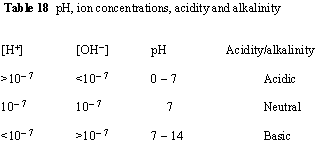|
12.8 Hydrogen ion concentration pH
Every aqueous solution whether acidic, alkaline
or neutral contains both H+
and OH- ions. The product of their concentrations is always constant
equal to 1 ´
10 -14
at 298 K.
In 1909, Sorensen introduced a convenient
scale to find out H+ ion concentration
which he called the pH scale.
In the symbol pH, ’p’ stands for protenz (meaning strength) and ’H’ for hydrogen in concentration.
So pH is defined as the negative logarithm to the base 10 of molar concentration of hydrogen ions.
pH = -
log10
[ H+
] = log10
For pure water and neutral solution [ H+
] = 1 ´
10- 7
\
pH = log10 [H+
] = - log (1 ´
10- 7)
= 7
pH Scale
In most practical cases the concentrations of H+
ions varies from100
to 10 -14
mol dm3 i.e. from
10-14
pH which is the basis of the pH scale. The mid point of the scale
i.e. pH = 7 represents a neutral solution. If the pH value is less
than 7 the solution is acidic and if it is more than 7, then the
solution is alkaline.

[next page]
|